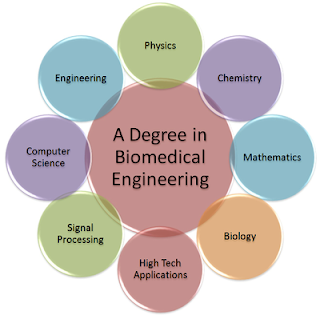 Here, Get introduction to Biomedical Engineering for having basic understanding of Biomedical Engineering.
Here, Get introduction to Biomedical Engineering for having basic understanding of Biomedical Engineering. Biomedical engineering (BME) is the application of engineering principles and design concepts to medicine and biology for healthcare purposes (e.g. diagnostic or therapeutic).
=> Definition of Biomedical Engineering:
Biomedical engineering is a discipline that advances knowledge in engineering, biology and medicine, and improves human health through cross-disciplinary activities that integrate the engineering sciences with the biomedical sciences and clinical practice. It includes:
1. The acquisition of new knowledge and understanding of living systems through the innovative and substantive application of experimental and analytical techniques based on the engineering sciences.
2. The development of new devices, algorithms, processes and systems that advance biology and medicine and improve medical practice and health care delivery.
The term "biomedical engineering research" is thus defined in a broad sense: It includes not only the relevant applications of engineering to medicine but also to the basic life sciences.
=> Development of Bioengineering:
Over the last few years there has been a major paradigm shift in both Europe and the United States away from traditional schemes of health care towards health care systems which are much more dependent on technology. This is true in terms of diagnosis (eg body scanners); treatment (radiation therapy and minimal access surgery); and health care system integration (via information technology).
In parallel with these changes, there has been a progressive increase in the proportion of the national Gross Domestic Product spent in the medical sector. For example, in the United Kingdom it is currently between 6 and 7%, in Germany about 9%, and in the United States about 14%. This has resulted partly from demographic changes and additionally from increasing public demand for better health care.
As medical practice becomes more technologically based, a progressive shift is occurring in industry to meet the demand. Developments in science and engineering are increasingly being directed away from traditional technologies towards those required for health care in its widest sense. Although in many countries there is a problem with escalating costs in the medical sector, technology can contribute to economies because of falling costs of electronic/physics based components relative to those for personnel, and because of technologically based screening programmes.
=> What are the Specialty Areas?
Some of the well established specialty areas within the field of biomedical engineering are bioinstrumentation, biomechanics, biomaterials, systems physiology, clinical engineering, and rehabilitation engineering.
Bioinstrumentation is the application of electronics and measurement principles and techniques to develop devices used in diagnosis and treatment of disease. Computers are becoming increasingly important in bioinstrumentation, from the microprocessor used to do a variety of small tasks in a single purpose instrument to the extensive computing power needed to process the large amount of information in a medical imaging system.
Biomechanics is mechanics applied to biological or medical problems. It includes the study of motion, of material deformation, of flow within the body and in devices, and transport of chemical constituents across biological and synthetic media and membranes. Efforts in biomechanics have developed the artificial heart and replacement heart valves, the artificial kidney, the artificial hip, as well as built a better understanding of the function of organs and musculoskeletal systems.
Biomaterials describes both living tissue and materials used for implantation. Understanding the properties of the living material is vital in the design of implant materials. The selection of an appropriate material to place in the human body may be one of the most difficult tasks faced by the biomedical engineer. Certain metal alloys, ceramics, polymers, and composites have been used as implantable materials. Biomaterials must be nontoxic, noncarcinogenic, chemically inert, stable, and mechanically strong enough to withstand the repeated forces of a lifetime.
Systems physiology is the term used to describe that aspect of biomedical engineering in which engineering strategies, techniques and tools are used to gain a comprehensive and integrated understanding of the function of living organisms ranging from bacteria to humans. Modeling is used in the analysis of experimental data and in formulating mathematical descriptions of physiological events. In research, models are used in designing new experiments to refine our knowledge. Living systems have highly regulated feedback control systems which can be examined in this way. Examples are the biochemistry of metabolism and the control of limb movements.
Clinical engineering is the application of technology for health care in hospitals. The clinical engineer is a member of the health care team along with physicians, nurses and other hospital staff. Clinical engineers are responsible for developing and maintaining computer databases of medical instrumentation and equipment records and for the purchase and use of sophisticated medical instruments. They may also work with physicians on projects to adapt instrumentation to the specific needs of the physician and the hospital. This often involves the interface of instruments with computer systems and customized software for instrument control and data analysis. Clinical engineers feel the excitement of applying the latest technology to health care.
Rehabilitation engineering is a new and growing specialty area of biomedical engineering. Rehabilitation engineers expand capabilities and improve the quality of life for individuals with physical impairments. Because the products of their labor are so personal, often developed for particular individuals or small groups, the rehabilitation engineer often works directly with the disabled individual.
These specialty areas frequently depend on each other. Often the biomedical engineer who works in an applied field will use knowledge gathered by biomedical engineers working in more basic areas. For example, the design of an artificial hip is greatly aided by a biomechanical study of the hip. The forces which are applied to the hip can be considered in the design and material selection for the prosthesis. Similarly, the design of systems to electrically stimulate paralyzed muscle to move in a controlled way uses knowledge of the behavior of the human musculoskeletal system. The selection of appropriate materials used in these devices falls within the realm of the biomaterials engineer. These are examples of the interactions among the specialty areas of biomedical engineering.
=> Where do they Work?
Biomedical engineers are employed in industry, in hospitals, in research facilities of educational and medical institutions, in teaching, and in government regulatory agencies. They often serve a coordinating or interfacing function, using their background in both the engineering and medical fields. In industry, they may create designs where an indepth understanding of living systems and of technology is essential. They may be involved in performance testing of new or proposed products. Government positions often involve product testing and safety, as well as establishing safety standards for devices. In the hospital, the biomedical engineer may provide advice on the selection and use of medical equipment, as well as supervising its performance testing and maintenance. They may also build customized devices for special health care or research needs. In research institutions, biomedical engineers supervise laboratories and equipment, and participate in or direct research activities in collaboration with other researchers with such backgrounds as medicine, physiology, and nursing.
Some biomedical engineers are technical advisors for marketing departments of companies and some are in management positions. Some biomedical engineers also have advanced training in other fields. For example, many biomedical engineers also have an M.D. degree, thereby combining an understanding of advanced technology with direct patient care or clinical research.
=> Career Preparation:
The biomedical engineer should plan first and foremost to be a good engineer. Beyond this, he or she should have a working understanding of life science systems and terminology. Good communications skills are also important, because the biomedical engineer provides a link among professionals with medical, technical, and other backgrounds.
From our experience, a top-quality biomedical engineer must have an excellent knowledge of physiology so that he/she can make sound judgments in solving biomedical problems. When working in a specific area of biomedicine, it is also necessary to know how disease alters functions, this is the field of pathophysiology. With such knowledge, the biomedical engineer does not have to rely on others for information about living organisms.



0 Comment to "Introduction to BIOMEDICAL ENGINEERING"
Post a Comment
Comment HERE, to know more about this topic.